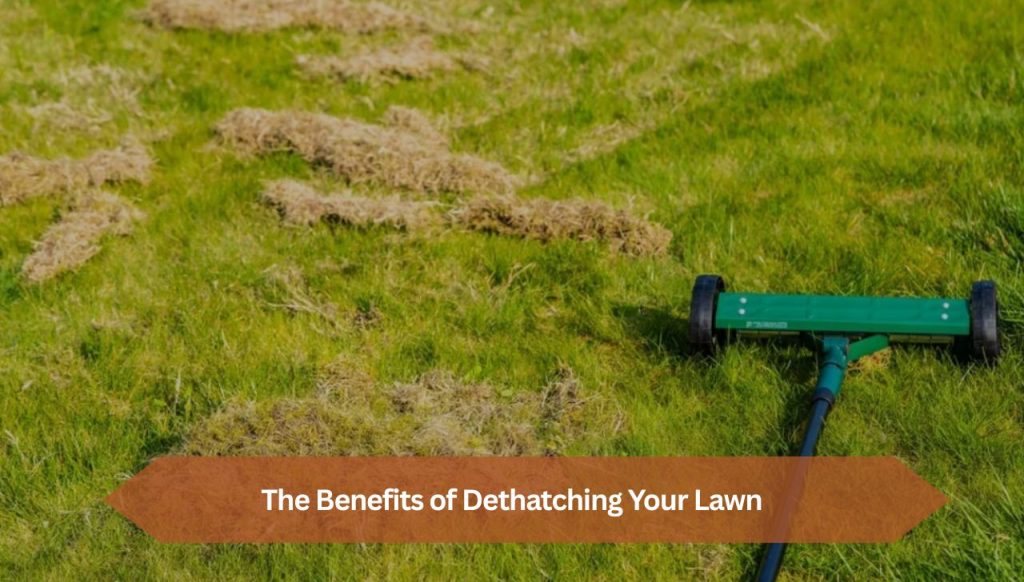If you’ve ever glanced at your grass and thought, “Why does it look so tired?”—you’re not alone. Healthy lawns require more than just water and sunshine. One overlooked but crucial aspect of lawn care is dethatching. It sounds intense, doesn’t it? Like something only pros do. But really, it’s something any homeowner can learn about, and it can make a world of difference if your lawn is struggling.
So what is dethatching, and should you be doing it? Let’s break it down.
What Is Lawn Dethatching and How Does It Work?
Dethatching is the process of removing the layer of dead grass, roots, and organic matter—known as “thatch”—that accumulates between the soil and the green grass blades. A little thatch is normal (even helpful). But when it gets too thick, it blocks water, air, and nutrients from reaching the roots.
You can dethatch your lawn using a dethatching rake (great for small areas), a power rake, or even a vertical mower for larger lawns. Each tool digs into the lawn and lifts out the excess thatch, kind of like combing out knots from tangled hair.
Continue Reading : Mushrooms In Lawn: Causes, Risks, and How to Manage Them

The Benefits of Dethatching Your Lawn
Done at the right time, dethatching can seriously boost your lawn’s health and appearance. Here’s how:
1. Better Absorption: With the excess thatch gone, water and fertilizer can actually get down to the roots—where they belong.
2. Improved Airflow: Roots need oxygen, too. Removing thatch helps aerate the soil and stimulates better root growth.
3. Greener, Thicker Grass: By removing the barrier that blocks nutrients, you encourage your lawn to fill out and look more lush.
4. Disease Control: Thatch can hold moisture like a sponge, making it a breeding ground for lawn diseases and pests. Clearing it reduces that risk.
5. Easier Lawn Maintenance: A dethatched lawn is easier to mow and maintain. Your mower blades won’t get gummed up, and you’ll spend less time fighting dead patches.
Common Drawbacks of Lawn Dethatching
Now, before you start ripping into your lawn, know this: dethatching isn’t a cure-all. And it can actually cause more harm than good if done at the wrong time or too often.
1. Stress on Grass: Dethatching can be rough on your lawn. If the grass is already stressed from heat or drought, dethatching may do more harm than good.
2. Potential Damage: Improper technique or the wrong equipment can tear up healthy grass along with the thatch.
3. Labor-Intensive: It’s not exactly a walk in the park. Dethatching is physically demanding, especially if you’re doing it manually.
4. Temporary Mess: After dethatching, your yard might look worse before it gets better. You’ll have piles of debris to clean up, and the grass can look patchy for a while.
5. Not Always Necessary: Some lawns don’t build up much thatch at all, especially if they’re well-maintained with proper mowing and watering techniques. Dethatching when it’s not needed can actually thin out your lawn.
When Should You Dethatch Your Lawn?
Timing is everything. Dethatch during the active growing season—when your grass can bounce back quickly. For cool-season grasses (like fescue or Kentucky bluegrass), early spring or early fall is ideal. For warm-season grasses (like Bermuda or zoysia), late spring through early summer works best.
As a rule of thumb, if your thatch layer is more than half an inch thick, it’s time to dethatch. You can check by removing a small section of your lawn with a spade and measuring the brown spongy layer.
Also, consider the weather. Avoid dethatching in extreme heat or drought. A few rainy days beforehand can soften the soil and make the job easier—just not when it’s soaking wet, or you’ll damage the roots.
Continue Reading : When to Fertilize Lawn: A Simple Guide for Healthy Grass
Conclusion
So—should you dethatch? Maybe. If your lawn feels springy, looks patchy, or you see that thick mat of thatch, it might be time. But if your lawn looks green, drains well, and isn’t plagued by pests or disease, you might not need to.
Think of dethatching like giving your lawn a good deep cleaning. It’s not something you do every week—just when things start feeling a bit off. Like with most yard work, balance is key. Too little, and your grass chokes under a layer of debris. Too much, and you might stress it out.
When in doubt, test your lawn. Measure the thatch, assess the grass health, and pick your tools wisely. Or, you know, grab a lemonade and call in a pro. Either way, a little attention goes a long way toward giving you that thick, lush lawn we all envy from the curb.

